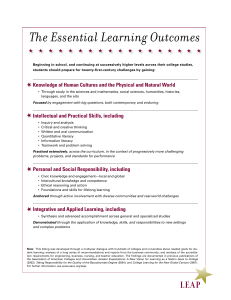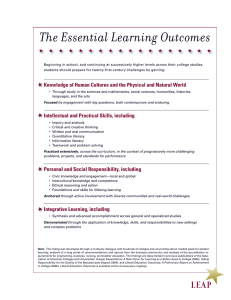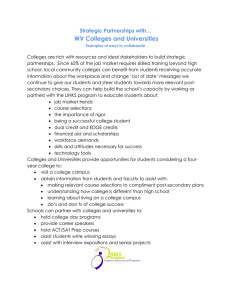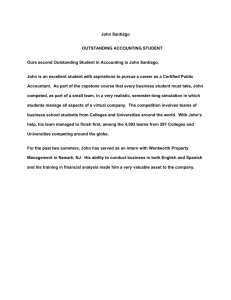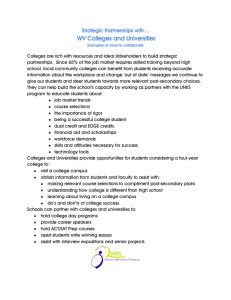KAUFFMAN-RAND INSTITUTE FOR ENTREPRENEURSHIP PUBLIC POLICY 6
advertisement
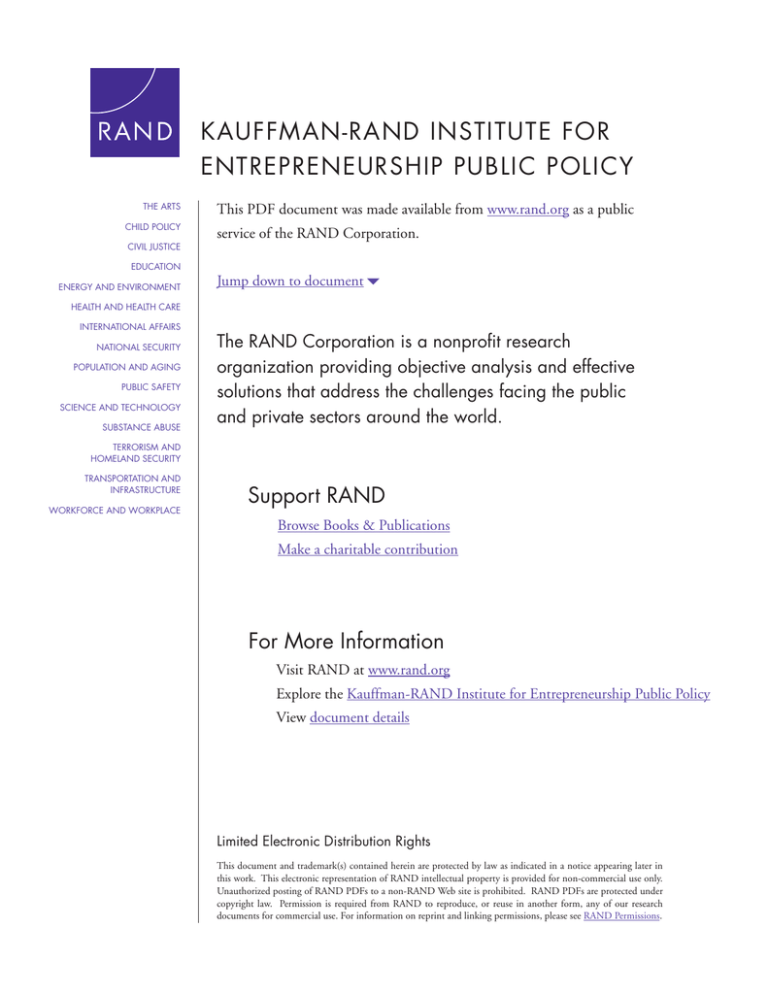
KAUFFMAN-RAND INSTITUTE FOR ENTREPRENEURSHIP PUBLIC POLICY THE ARTS CHILD POLICY CIVIL JUSTICE EDUCATION ENERGY AND ENVIRONMENT This PDF document was made available from www.rand.org as a public service of the RAND Corporation. Jump down to document6 HEALTH AND HEALTH CARE INTERNATIONAL AFFAIRS NATIONAL SECURITY POPULATION AND AGING PUBLIC SAFETY SCIENCE AND TECHNOLOGY SUBSTANCE ABUSE The RAND Corporation is a nonprofit research organization providing objective analysis and effective solutions that address the challenges facing the public and private sectors around the world. TERRORISM AND HOMELAND SECURITY TRANSPORTATION AND INFRASTRUCTURE WORKFORCE AND WORKPLACE Support RAND Browse Books & Publications Make a charitable contribution For More Information Visit RAND at www.rand.org Explore the Kauffman-RAND Institute for Entrepreneurship Public Policy View document details Limited Electronic Distribution Rights This document and trademark(s) contained herein are protected by law as indicated in a notice appearing later in this work. This electronic representation of RAND intellectual property is provided for non-commercial use only. Unauthorized posting of RAND PDFs to a non-RAND Web site is prohibited. RAND PDFs are protected under copyright law. Permission is required from RAND to reproduce, or reuse in another form, any of our research documents for commercial use. For information on reprint and linking permissions, please see RAND Permissions. This product is part of the RAND Corporation technical report series. Reports may include research findings on a specific topic that is limited in scope; present discussions of the methodology employed in research; provide literature reviews, survey instruments, modeling exercises, guidelines for practitioners and research professionals, and supporting documentation; or deliver preliminary findings. All RAND reports undergo rigorous peer review to ensure that they meet high standards for research quality and objectivity. Innovation in Academe Federal R&D Funding and the Patenting Activities of U.S. Universities and Colleges Donna Fossum, Elisa Eiseman, Connie S. Moreno, Lawrence S. Painter, Margaret E. Blume-Kohout Prepared for the Ewing Marion Kauffman Foundation KAUFFMAN-RAND INSTITUTE FOR ENTREPRENEURSHIP PUBLIC POLICY This research was prepared for the Ewing Marion Kauffman Foundation and was conducted within the Kauffman-RAND Institute for Entrepreneurship Public Policy in the RAND Institute for Civil Justice. The RAND Corporation is a nonprofit research organization providing objective analysis and effective solutions that address the challenges facing the public and private sectors around the world. RAND’s publications do not necessarily reflect the opinions of its research clients and sponsors. R® is a registered trademark. © Copyright 2009 RAND Corporation Permission is given to duplicate this document for personal use only, as long as it is unaltered and complete. Copies may not be duplicated for commercial purposes. Unauthorized posting of R AND documents to a non-R AND Web site is prohibited. R AND documents are protected under copyright law. For information on reprint and linking permissions, please visit the RAND permissions page (http://www.rand.org/publications/ permissions.html). Published 2009 by the RAND Corporation 1776 Main Street, P.O. Box 2138, Santa Monica, CA 90407-2138 1200 South Hayes Street, Arlington, VA 22202-5050 4570 Fifth Avenue, Suite 600, Pittsburgh, PA 15213-2665 RAND URL: http://www.rand.org To order RAND documents or to obtain additional information, contact Distribution Services: Telephone: (310) 451-7002; Fax: (310) 451-6915; Email: order@rand.org Summary Universities and colleges have long been recognized as critical sources of the innovative technologies needed to address the many challenges confronting the United States in particular, and society in general, from reducing pollution to improving transportation to curing disease. Since World War II, most university research and development (R&D) expenditures have been funded by the federal government. These R&D funds arrived at universities and colleges in the form of grants, cooperative agreements, or contracts that were, in virtually all cases, awarded competitively by a federal agency. Historically, the federal government was the presumptive owner of any intellectual property that resulted from federally funded R&D. The Bayh-Dole Act of 1980 (Pub. L. 96-517) changed this by explicitly shifting the right to patent any invention resulting from federally funded R&D from the federal government to the universities and colleges (and other nonprofit entities) at which the R&D was actually conducted. The act sparked the field of “Technology Transfer” for commercialization of academic research, in which universities and colleges not only patented the inventions that were discovered by their faculties (and students) using federal R&D funds but also actively marketed these inventions to others to promote their actual development and use and to generate income for the university or college from licensing the patents based on these inventions. In the nearly three decades since the Bayh-Dole Act changed the nation’s patent laws, some academic institutions have been much more prolific at patenting technologies and other inventions discovered in their laboratories than have other academic institutions. The purpose of this report is twofold. First, we describe a new data set available to researchers that contains complete information on the federal R&D funds that were officially provided to U.S. colleges and universities by all federal agencies by fiscal year (FY). These data will be of use to researchers interested in examining a number of issues related to federal funding of R&D at universities and colleges. Second, the report uses these data to explore the relationship between academic institutions’ relative federal R&D funding levels and their patenting activities since the passage of Bayh-Dole, to identify some of the characteristics associated with a higher propensity to patent.1 1 Due to the lack of availability of some data at the time these analyses were conducted, an earlier iteration of the data was used for all analyses presented in this report. (See Appendix A for a more detailed explanation of the sets of data used.) ix x Innovation in Academe: Federal R&D Funding and the Patenting Activities of U.S. Universities and Colleges Construction of a Special Set of Data on Federal R&D Funding To conduct this analysis, we constructed a special set of data on the federal R&D funding going to universities and colleges by federal agency and fiscal year from information contained in the RAND Database of Research and Development in the United States (RaDiUS). These data are described in detail in Appendix A. During its existence from the mid-1990s until 2008, RaDiUS systematically tracked all federal R&D funds from their point of planning and allocation at the White House and top federal agency levels, through the various levels of the federal bureaucracy to the many thousands of entities, including universities and colleges, that would actually conduct the R&D. Analytical Approach In this report, we present detailed descriptive information on the federal R&D funding received by academic institutions in FY 2005 using the set of data described in the previous section. To analyze patent data, we created a comprehensive data set of the utility and plant patents that had been granted by the U.S. Patent and Trademark Office (USPTO) to universities and colleges, using data obtained directly from the searchable database maintained by USPTO (PatFT for Patent Full-Text and Image Database). We looked both at the number of patents issued in 2005 and at the total number of patents issued between 1981 and 2005. Using these data sources, we ranked academic institutions in terms of their federal R&D funding as well as their patent output. We then compared rankings on the two measures to generate insights. We took this approach in recognition of the fact that there is not a causal link between the amount of federal R&D funds received by a university or college in a given year and the number of patents issued to that university or college in the same year. Rather, we wanted to see whether the two variables were related and, if so, how strongly. Findings We found that there is a strong association between the amount of federal R&D funds received by a university or college and the number of patents granted to the same institution. We found that 96 of the universities and colleges that were among the top 100 recipients of federal R&D funds in FY 2005 were also among the top 100 colleges and universities, or systems thereof, that obtained patents between 1981 and 2005. We also found that academic institutions, or systems thereof, that have medical schools receive a significant share of all federal R&D funds going to universities and colleges and account for a significant share of all college and university patenting. Our analysis found that 44 percent of all federal R&D funds that went to the nation’s universities and colleges in FY 2005 went directly to 125 of the nation’s 126 medical schools. Eighty-four of the top 100 universities/colleges and university systems receiving patents from 1981 to 2005 had at least one of the nation’s 126 medical schools. Among the top 50 universities/colleges and university systems receiving patents between 1981 and 2005, 39 institutions had one or more medical schools. Academic institutions that manage or operate a federally funded R&D center (FFRDC) were also among the top recipients of patents. Indeed, ten of the top 50 academic Summary xi institutions that obtained the most patents between 1981 and 2005 managed or operated FFRDCs; seven of the ten academic institutions that obtained the most patents between 1981 and 2005 managed or operated FFRDCs. Overall, our analysis indicates a strong association between the amount of federal R&D funds received by an academic institution and the number of patented technological innovations actually generated by that same academic institution. There may be a number of explanations for this strong association. Interestingly, a careful review of the individual patents granted in 2005 to the six U.S. universities and colleges, or university systems thereof, at which more than 70 percent of all the federal R&D funds that they received in FY 2005 went to their medical school(s), indicates that the vast majority of the patents that were obtained by these institutions in 2005 were indeed related to biomedical technologies. One factor that likely influences the number of patentable technologies generated by universities and colleges that conduct federally funded R&D is the nature (i.e., stage) of the R&D that specific federal agencies, and parts thereof, want universities and colleges to conduct with the funds that the agencies provide. That is, as part of the annual budget process, every federal agency that supports R&D activities—be they conducted intramurally by federal employees or extramurally by universities, colleges, and other entities—categorizes all of the R&D dollars that it spends as to whether these dollars are funding Basic Research, Applied Research, or Development. Of these three “Stages of R&D,” Applied Research is the R&D work that is most likely to generate patentable technologies for universities and colleges or any other entity conducting such R&D. Federal agencies fund drastically different portfolios of R&D activities—with direct ramifications for what R&D funded by federal agencies would most likely lead to patentable technologies. For example, 91 percent of the $70+ billion that the U.S. Department of Defense (DoD) spent on the conduct of R&D in FY 2005 was for Development work; in contrast, only 7 percent was for Applied Research. The source of R&D funds that could most likely lead to patents is the U.S. Department of Health and Human Services (HHS). As the home of the National Institutes of Health (NIH), which controls more than 95 percent of HHS’s R&D funds, more than 40 percent of NIH’s funds were spent on Applied Research in FY 2005. Or, viewed another way, in FY 2005, NIH alone funded more Applied Research than did DoD, the National Aeronautics and Space Administration (NASA), the U.S. Department of Energy (DOE), the National Science Foundation (NSF), and the U.S. Department of Agriculture (USDA) combined. Conclusions The federal government has used its R&D spending power to stoke the creative engines at the nation’s universities and colleges primarily in the field of life sciences. The exploratory analysis provided here suggests that there is a relationship between the provision of funds by the federal government to universities and colleges for the conduct of Applied Research and the generation of patentable technologies by these institutions, at least some of which are hopefully usable and a few of which could be revolutionary. The set of data created to conduct this analysis and shared in conjunction with this report can hopefully be used by others to support additional research to improve policymakers’ understanding of the relationship between federal R&D funds provided to academic institutions on the one hand and university innovation and entrepreneurship on the other. Such insights could inform critical policy decisions, such as whether xii Innovation in Academe: Federal R&D Funding and the Patenting Activities of U.S. Universities and Colleges the federal government should consider specifically providing funds to universities and colleges to conduct Applied Research on the many challenges presented by fields other than biomedical science and health care.

